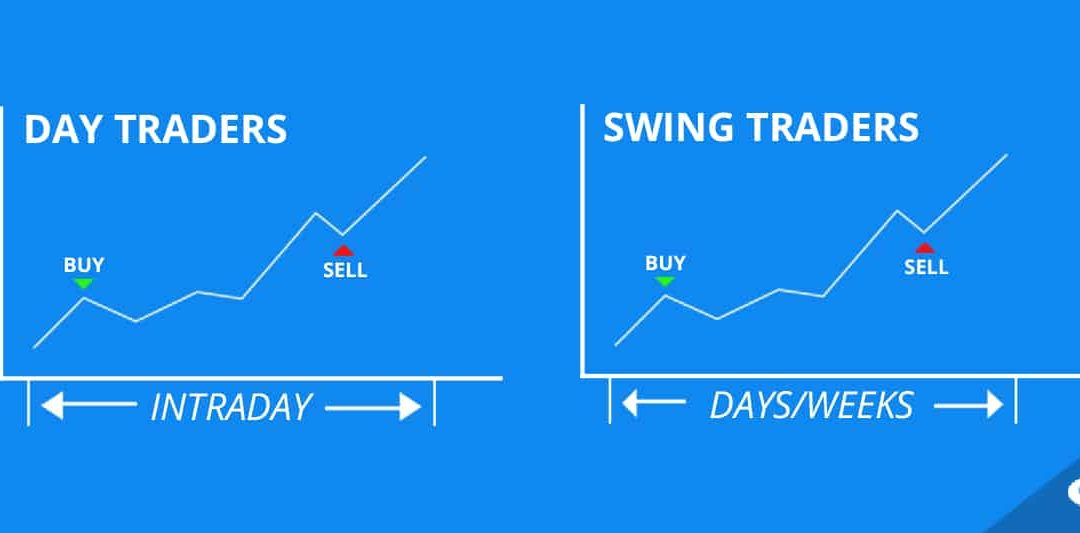Day trading and swing trading are two popular trading styles employed by traders in the financial markets, each with its own characteristics, strategies, and objectives. Here’s a detailed comparison of day trading and swing trading:
Time Horizon:
Day Trading: Day trading involves buying and selling financial instruments within the same trading day, with all positions closed out before the market closes. Day traders aim to capitalize on intraday price movements and typically do not hold positions overnight, minimizing exposure to overnight market risks.
Swing Trading: Swing trading involves holding positions for several days to weeks, capturing short- to medium-term price movements within the context of broader market trends. Unlike day traders, swing traders have a longer time horizon and are willing to hold positions overnight or over weekends to take advantage of favorable price swings.
Trading Frequency:
Day Trading: Day traders execute multiple trades throughout the trading day, often entering and exiting positions within minutes or hours. Day trading requires active monitoring of the markets and rapid decision-making to capitalize on short-term opportunities.
Swing Trading: Swing traders execute fewer trades compared to day traders, typically entering and exiting positions less frequently. Swing traders may hold multiple positions simultaneously and allow trades to develop over several days or weeks, requiring less frequent monitoring of the markets.
Risk and Reward:
Day Trading: Day trading can be high-risk, high-reward, as traders aim to generate profits from short-term price movements. Day traders often use leverage to amplify returns, but this also increases the potential for losses. Successful day traders focus on strict risk management, controlling position sizes, and using stop-loss orders to limit downside risk.
Swing Trading: Swing trading tends to have a lower risk profile compared to day trading, as trades are held for longer periods and are subject to less intraday volatility. Swing traders aim to capture larger price swings and trends, which can result in higher potential profits compared to day trading. However, swing trading also requires patience and discipline to withstand short-term price fluctuations and market noise.
Analysis and Strategy:
Day Trading: Day traders primarily rely on technical analysis and intraday chart patterns to identify short-term trading opportunities. They use technical indicators, such as moving averages, RSI, MACD, and volume analysis, to confirm trade signals and assess market momentum. Day traders focus on short-term price action and intraday trends, often trading based on minute or hourly charts.
Swing Trading: Swing traders use a combination of technical and fundamental analysis to identify potential swing trading opportunities. They analyze longer-term price charts, such as daily or weekly charts, to identify trends, support and resistance levels, and chart patterns. Swing traders also consider fundamental factors, market news, and economic indicators that can impact longer-term price movements.
Capital Requirements:
Day Trading: Day trading typically requires higher capital requirements compared to swing trading, as day traders need sufficient capital to meet margin requirements and cover potential losses resulting from intraday price movements. Day traders may also incur higher trading costs, including commissions and fees associated with frequent trading activity.
Swing Trading: Swing trading can be more accessible to traders with smaller trading accounts, as it requires less frequent trading and lower margin requirements compared to day trading. Swing traders can hold positions for several days or weeks, allowing them to spread out capital over multiple trades and reduce trading costs.
Psychological Considerations:
Day Trading: Day trading requires a high level of focus, discipline, and emotional control, as traders must make rapid decisions under pressure and react quickly to changing market conditions. Day traders face the psychological challenges of dealing with intraday volatility, managing emotions such as fear and greed, and avoiding impulsive trading decisions.
Swing Trading: Swing trading requires patience, perseverance, and the ability to tolerate short-term price fluctuations. Swing traders must remain disciplined and stick to their trading plans, even during periods of drawdowns or market uncertainty. Successful swing traders focus on the long-term trend and avoid getting distracted by short-term noise.
In summary, while both day trading and swing trading offer opportunities for profit in the financial markets, they differ in terms of time horizon, trading frequency, risk and reward profile, analysis and strategy, capital requirements, and psychological considerations. Traders should carefully consider their trading objectives, risk tolerance, and personal preferences when choosing between day trading and swing trading as their preferred trading style.

